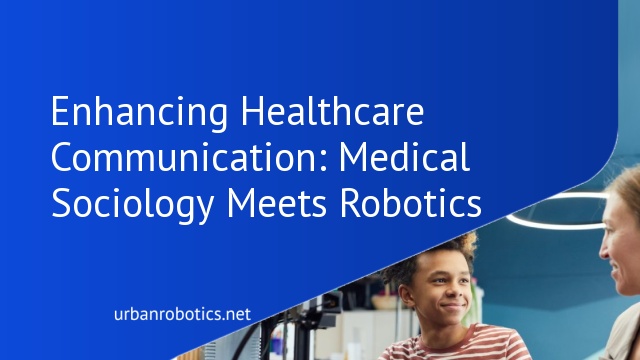Understanding Medical Sociology
Medical sociology examines the intricate relationship between social factors and healthcare. It’s essential for understanding how societal dynamics influence health outcomes, patient behavior, and the structure of healthcare systems. By analyzing social determinants like economic status, ethnicity, and family structure, we can identify patterns that impact health disparities.
Medical sociology also explores how medical institutions function within society. This includes studying the roles of healthcare providers, patient interactions, and the organization of healthcare services. These insights help in developing interventions that are socially aware, ensuring healthcare services are accessible and effective for diverse populations.
Incorporating medical sociology in healthcare communication, especially with the integration of robotics, is crucial. Robots in healthcare settings must navigate social contexts and human interactions. Medical sociology principles guide the design and implementation of robotic systems that complement human care, promoting trust and adherence among patients.
The discipline emphasizes the importance of ethics in healthcare technology. As we integrate more robotic systems, understanding their impact on the patient-provider relationship is vital. Medical sociology provides the frameworks needed to ensure these technologies enhance, rather than hinder, human elements of care.
The Role of Robotics in Healthcare
Innovations in robotics are transforming healthcare delivery. These advancements improve efficiency, precision, and patient outcomes.
Technological Advancements
Robotic technologies are revolutionizing medical procedures. Advanced robotic arms assist in surgeries, allowing for minimally invasive techniques. AI-driven diagnostic tools provide faster, more accurate disease detection. Autonomous robots transport medication and supplies, reducing human error. These technologies optimize workflows, improving overall healthcare.
Current Applications
Robots are actively used in various medical fields. Surgical robots perform complex procedures with precision, like Da Vinci systems used in urology and gastroenterology. Rehabilitation robots aid patients in physical therapy, enhancing recovery rates. In elder care, robots assist with daily activities, providing companionship and monitoring health metrics. Telepresence robots facilitate remote consultations, bridging gaps in healthcare access.
Integrating Medical Sociology and Robotics
Integrating medical sociology with robotics in healthcare involves leveraging social science principles to optimize robotic system design and patient interaction.
Enhancing Patient Communication
Effective communication is critical in healthcare. Medical sociology provides insights into social behaviors and communication patterns, essential for developing robots that can interact empathetically with patients. For example, robots designed with these insights can recognize patients’ non-verbal cues like body language and facial expressions. This capability enhances patient trust and satisfaction, making healthcare interactions more human-like and supportive.
Overcoming Sociological Barriers
Sociological barriers, such as socio-economic disparities and cultural differences, can hinder healthcare access and quality. By applying medical sociology principles, robotic systems can be tailored to accommodate diverse patient needs. For instance, these systems can offer multilingual support and adaptive interfaces for patients with varying literacy levels. This approach ensures that robotic solutions are inclusive, promoting equitable healthcare access and improving overall patient outcomes.
Case Studies and Real-World Examples
Real-world applications illustrate the integration of medical sociology and robotics in healthcare. By examining successful implementations and identifying challenges, we gain insights into enhancing these systems for better patient outcomes.
Successful Implementations
In Japan, robotic caregivers in elder care facilities have shown significant success. These robots, equipped with sociological algorithms, assist with daily activities and provide companionship, reducing loneliness among seniors. Another example is the use of AI-driven diagnostic tools in the United States, which analyze patient data to offer precise diagnoses, thus improving patient-doctor communication. In Sweden, multilingual robots in hospitals facilitate communication between healthcare providers and patients from diverse backgrounds, ensuring equitable access to quality care.
Challenges and Learnings
There are notable challenges in integrating medical sociology with robotics. Inconsistent patient acceptance can hinder implementation, as observed in some elder care facilities. Cultural biases embedded in programming algorithms may lead to unequal care delivery, as seen in AI diagnostic tools. Additionally, the high cost of advanced robots limits their accessibility in low-income regions. Addressing these issues requires ongoing research, inclusive design practices, and policy support to ensure that robotics enhance rather than hinder healthcare communication and delivery.
Future Prospects and Trends
Exploration of emerging technologies in medical sociology and healthcare communication with robotics indicates promising developments. Autonomous robots with advanced AI and machine learning capabilities could perform complex tasks like surgery, diagnostics, and personalized patient care. By 2030, we expect significant growth in AI applications in healthcare, addressing diverse patient needs more effectively.
Wearable health technology and remote robotic systems offer opportunities for continuous patient monitoring, especially in rural areas. For instance, remote surgery using robotic arms can enhance access to specialized medical care globally. This potential alignment can reduce healthcare disparities by providing equal access to quality medical services.
The integration of natural language processing (NLP) in healthcare robots can revolutionize patient-robot interactions. These systems, capable of understanding and responding to patient queries in real-time, improve patient satisfaction and engagement. Expected advancements in NLP could lead to seamless communication, translating complex medical jargon into easily understandable language.
Legal and ethical frameworks are evolving to address the integration of robotics in healthcare. Policies ensuring safe and equitable use of robotic systems are crucial. Research and collaborative efforts will drive these advancements, balancing innovation, patient safety, and ethical considerations, ensuring that future healthcare robotics enhances patient outcomes and healthcare delivery.
Conclusion
As we embrace the intersection of medical sociology and robotics in healthcare, it’s clear that understanding social dynamics is key to optimizing robotic systems for patient interaction. By integrating sociological principles, we can address health disparities and enhance communication, ensuring robots interact empathetically and effectively with diverse populations.
While real-world examples showcase successful implementations, challenges like patient acceptance and cultural biases remain. Looking forward, advancements in AI and natural language processing hold promise for more sophisticated and accessible healthcare robotics.
Continued research, collaboration, and evolving legal frameworks will be essential in driving innovation while maintaining patient safety and ethical standards. By prioritizing these elements, we can achieve more equitable and effective healthcare delivery for all.





